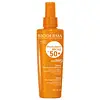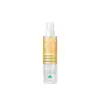What's inside
What's inside
 Key Ingredients
Key Ingredients

 Benefits
Benefits

 Concerns
Concerns

 Ingredients Side-by-side
Ingredients Side-by-side

Water
Skin ConditioningDicaprylyl Carbonate
EmollientOctocrylene
UV AbsorberMethylene Bis-Benzotriazolyl Tetramethylbutylphenol
UV FilterButyl Methoxydibenzoylmethane
UV AbsorberBis-Ethylhexyloxyphenol Methoxyphenyl Triazine
Skin ConditioningGlycerin
HumectantMethylpropanediol
SolventEctoin
Skin ConditioningMannitol
HumectantXylitol
HumectantRhamnose
HumectantFructooligosaccharides
HumectantLaminaria Ochroleuca Extract
Skin ConditioningAcetyl Tyrosine
Skin ConditioningHelianthus Annuus Seed Oil
EmollientOleoyl Tyrosine
Skin ConditioningMedicago Sativa Extract
TonicSqualane
EmollientJuglans Regia Shell Extract
Skin ConditioningHypericum Perforatum Extract
AntimicrobialAcetyl Hexapeptide-1
Skin ConditioningDextran
Isopropyl Myristate
EmollientDecyl Glucoside
CleansingC20-22 Alkyl Phosphate
EmulsifyingC20-22 Alcohols
Emulsion StabilisingTrilinolein
Skin ConditioningAspartic Acid
MaskingCetearyl Alcohol
EmollientXanthan Gum
EmulsifyingCoco-Glucoside
CleansingButylene Glycol
HumectantTrilinolenin
EmollientTriolein
Skin ConditioningHydroxyethyl Acrylate/Sodium Acryloyldimethyl Taurate Copolymer
Emulsion StabilisingOleic Acid
EmollientTripalmitin
Skin ConditioningTristearin
Skin ConditioningPropylene Glycol
HumectantPolysorbate 60
EmulsifyingCopper Gluconate
Skin ConditioningCaprylic/Capric Triglyceride
MaskingCitric Acid
BufferingSodium Hydroxide
BufferingDisodium EDTA
Chlorphenesin
AntimicrobialPhenoxyethanol
PreservativeParfum
MaskingWater, Dicaprylyl Carbonate, Octocrylene, Methylene Bis-Benzotriazolyl Tetramethylbutylphenol, Butyl Methoxydibenzoylmethane, Bis-Ethylhexyloxyphenol Methoxyphenyl Triazine, Glycerin, Methylpropanediol, Ectoin, Mannitol, Xylitol, Rhamnose, Fructooligosaccharides, Laminaria Ochroleuca Extract, Acetyl Tyrosine, Helianthus Annuus Seed Oil, Oleoyl Tyrosine, Medicago Sativa Extract, Squalane, Juglans Regia Shell Extract, Hypericum Perforatum Extract, Acetyl Hexapeptide-1, Dextran, Isopropyl Myristate, Decyl Glucoside, C20-22 Alkyl Phosphate, C20-22 Alcohols, Trilinolein, Aspartic Acid, Cetearyl Alcohol, Xanthan Gum, Coco-Glucoside, Butylene Glycol, Trilinolenin, Triolein, Hydroxyethyl Acrylate/Sodium Acryloyldimethyl Taurate Copolymer, Oleic Acid, Tripalmitin, Tristearin, Propylene Glycol, Polysorbate 60, Copper Gluconate, Caprylic/Capric Triglyceride, Citric Acid, Sodium Hydroxide, Disodium EDTA, Chlorphenesin, Phenoxyethanol, Parfum
Water
Skin ConditioningDicaprylyl Carbonate
EmollientUndecane
EmollientIsoamyl Laurate
EmollientDiisopropyl Adipate
EmollientBis-Ethylhexyloxyphenol Methoxyphenyl Triazine
Skin ConditioningDiethylamino Hydroxybenzoyl Hexyl Benzoate
UV FilterTridecane
PerfumingEthylhexyl Triazone
UV AbsorberHexylene Glycol
EmulsifyingNiacinamide
SmoothingSodium Chloride
MaskingBixa Orellana Seed Extract
MaskingGlycine Soja Oil
EmollientLepidium Sativum Sprout Extract
Skin ConditioningHelianthus Annuus Seed Oil
EmollientTocopherol
AntioxidantCaprylic/Capric Triglyceride
MaskingCitric Acid
BufferingCoco-Betaine
CleansingPotassium Sorbate
PreservativeSodium Benzoate
MaskingParfum
MaskingWater, Dicaprylyl Carbonate, Undecane, Isoamyl Laurate, Diisopropyl Adipate, Bis-Ethylhexyloxyphenol Methoxyphenyl Triazine, Diethylamino Hydroxybenzoyl Hexyl Benzoate, Tridecane, Ethylhexyl Triazone, Hexylene Glycol, Niacinamide, Sodium Chloride, Bixa Orellana Seed Extract, Glycine Soja Oil, Lepidium Sativum Sprout Extract, Helianthus Annuus Seed Oil, Tocopherol, Caprylic/Capric Triglyceride, Citric Acid, Coco-Betaine, Potassium Sorbate, Sodium Benzoate, Parfum
Ingredients Explained
These ingredients are found in both products.
Ingredients higher up in an ingredient list are typically present in a larger amount.
You might know this ingredient as Tinosorb S or Bemotrizinol. It is a UV filter that covers both UVA and UVB rays.
This ingredient has two peak UV absorption peaks ( 310 and 340 nm) and is able to absorb both UV-A and UV-B rays. This ingredient works by preventing UV rays from reaching and damaging your skin.
On top of that - it is highly photostable and helps prevent the photodegration of other sunscreen ingredients such as avobenzone.
Tinosorb S is allowed in the EU, Australia, and Asia. It is close to being approved by the FDA and we'll hopefully get this ingredient in the U.S. by late 2025.
Fun fact: Tinosorb S is the most effective UV absorber at maximum concentration (measured by SPF) permitted in the EU.
This ingredient is oil-soluble, so your oil-cleansers will take this right off at night.
Learn more about Bis-Ethylhexyloxyphenol Methoxyphenyl TriazineThis ingredient is an emollient, solvent, and texture enhancer. It is considered a skin-softener by helping the skin prevent moisture loss.
It helps thicken a product's formula and makes it easier to spread by dissolving clumping compounds.
Caprylic Triglyceride is made by combining glycerin with coconut oil, forming a clear liquid.
While there is an assumption Caprylic Triglyceride can clog pores due to it being derived from coconut oil, there is no research supporting this.
Learn more about Caprylic/Capric TriglycerideCitric Acid is an alpha hydroxy acid (AHA) naturally found in citrus fruits like oranges, lemons, and limes.
Like other AHAs, citric acid can exfoliate skin by breaking down the bonds that hold dead skin cells together. This helps reveal smoother and brighter skin underneath.
However, this exfoliating effect only happens at high concentrations (20%) which can be hard to find in cosmetic products.
Due to this, citric acid is usually included in small amounts as a pH adjuster. This helps keep products slightly more acidic and compatible with skin's natural pH.
In skincare formulas, citric acid can:
While it can provide some skin benefits, research shows lactic acid and glycolic acid are generally more effective and less irritating exfoliants.
Most citric acid used in skincare today is made by fermenting sugars (usually from molasses). This synthetic version is identical to the natural citrus form but easier to stabilize and use in formulations.
Read more about some other popular AHA's here:
Learn more about Citric AcidDicaprylyl Carbonate comes from carbonic acid and caprylyl alcohol, a fatty alcohol. It is an emollient and gives skin a velvet feel. The sources of Dicaprylyl Carbonate may be synthetic or from animals.
As an emollient, Dicaprylyl Carbonate creates a film on the skin. This film traps moisture in, keeping your skin soft and hydrated.
Helianthus Annuus Seed Oil is the oil derived from the seeds of a Sunflower. Sunflower seed oil is non-fragrant. It is an emollient, meaning it helps to soften the skin.
Sunflower seed oil contains many fatty acids. The fatty acids found in sunflower seeds include (from highest amount to least): linoleic acid, myristic acid, palmitic acid, stearic acid, arachidic acid, oleic acid, and linolenic acid.
These fatty acids help the skin create ceramides. Ceramides play a role in repairing the skin barrier.
Helianthus Annuus Seed Oil helps moisturize the skin. This in turn helps the skin look more rejuvenated and smoother.
Sunflowers are rich in vitamin E.
Historians believe Indigenous cultures of North America domesticated sunflowers before corn. Thus they relied on sunflower oil for a variety of uses. One such use is moisturizing skin and hair.
Sunflower seed oil may not be fungal acne safe. We recommend speaking with a professional if you have any concerns.
Learn more about Helianthus Annuus Seed OilParfum is a catch-all term for an ingredient or more that is used to give a scent to products.
Also called "fragrance", this ingredient can be a blend of hundreds of chemicals or plant oils. This means every product with "fragrance" or "parfum" in the ingredients list is a different mixture.
For instance, Habanolide is a proprietary trade name for a specific aroma chemical. When used as a fragrance ingredient in cosmetics, most aroma chemicals fall under the broad labeling category of “FRAGRANCE” or “PARFUM” according to EU and US regulations.
The term 'parfum' or 'fragrance' is not regulated in many countries. In many cases, it is up to the brand to define this term.
For instance, many brands choose to label themselves as "fragrance-free" because they are not using synthetic fragrances. However, their products may still contain ingredients such as essential oils that are considered a fragrance by INCI standards.
One example is Calendula flower extract. Calendula is an essential oil that still imparts a scent or 'fragrance'.
Depending on the blend, the ingredients in the mixture can cause allergies and sensitivities on the skin. Some ingredients that are known EU allergens include linalool and citronellol.
Parfum can also be used to mask or cover an unpleasant scent.
The bottom line is: not all fragrances/parfum/ingredients are created equally. If you are worried about fragrances, we recommend taking a closer look at an ingredient. And of course, we always recommend speaking with a professional.
Learn more about ParfumWater. It's the most common cosmetic ingredient of all. You'll usually see it at the top of ingredient lists, meaning that it makes up the largest part of the product.
So why is it so popular? Water most often acts as a solvent - this means that it helps dissolve other ingredients into the formulation.
You'll also recognize water as that liquid we all need to stay alive. If you see this, drink a glass of water. Stay hydrated!
Learn more about Water